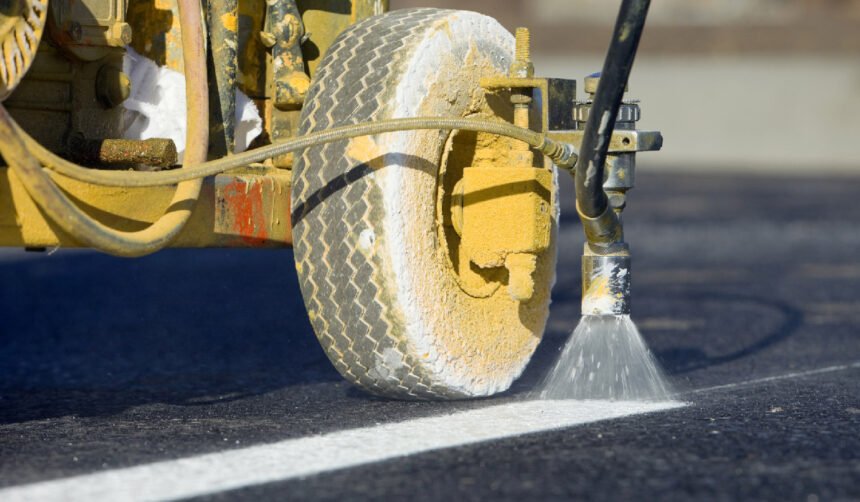When it comes to managing roads, parking lots, or industrial facilities, clear and effective pavement markings are far more than cosmetic details—they’re essential tools for safety, navigation, and compliance. Pavement striping plays a critical role in guiding drivers, organizing traffic flow, and ensuring that every vehicle and pedestrian moves through a space efficiently and securely.
Despite its importance, striping is often overlooked during facility upgrades or construction planning. Faded lines, inconsistent markings, or missing symbols can lead to traffic confusion, violations, or even accidents. Whether you manage a commercial parking facility, a private road network, or a busy warehouse loading zone, understanding the value of professional striping is crucial.
This article covers everything you need to know about pavement striping—from its function and benefits to materials, techniques, and how to choose the right service provider.
Why Pavement Striping Matters
Pavement markings serve as a silent but powerful communication system. They guide vehicle and pedestrian movement without the need for verbal instructions or signage. A well-striped surface helps prevent collisions, enforces regulations, and keeps environments orderly.
1. Enhanced Safety
Safety is the top priority in any environment where vehicles and people interact. Clear striping helps define lanes, crosswalks, fire lanes, and no-parking zones. It also ensures that traffic signals, stop bars, and arrows are easily understood by all users.
2. Improved Traffic Flow
With precise and logical markings, vehicles can navigate complex areas such as intersections, roundabouts, and tight parking structures more efficiently. This minimizes traffic congestion and reduces the chances of wrong-way driving or illegal turns.
3. Regulatory Compliance
Many regulations require specific types of pavement markings for public and private spaces. These include ADA (Americans with Disabilities Act) compliance for accessible parking spaces, local fire codes for fire lane markings, and zoning rules for directional flow.
4. Better User Experience
For commercial properties, a well-striped parking lot or driveway reflects professionalism and attention to detail. Customers are more likely to feel comfortable and safe in spaces where movement and parking are clearly defined.
Common Applications of Pavement Striping
Striping isn’t just for highways. There are numerous use cases where precise markings are necessary to manage traffic, enforce rules, and promote safe access.
A. Parking Lot Striping
One of the most common applications, parking lot striping includes individual parking spaces, ADA-compliant spots, directional arrows, and pedestrian crossings.
B. Roadway and Highway Striping
Lane markings, centerlines, edge lines, and turning lanes are crucial for guiding high-speed traffic and maintaining proper lane discipline.
C. Warehouse and Industrial Facilities
Inside and outside of warehouses, striping is used to designate loading zones, pedestrian walkways, forklift lanes, and hazard zones.
D. School and Campus Zones
These areas benefit from high-visibility crosswalks, drop-off zones, no-parking areas, and directional guidance for staff, students, and visitors.
E. Airport and Transportation Hubs
Pavement markings in these areas manage the movement of commercial and service vehicles, guide pedestrian traffic, and maintain safety near terminals and runways.
Materials Used in Pavement Striping
Different types of striping require different materials, depending on traffic levels, environmental conditions, surface type, and budget. A professional pavement striping contractor will recommend the most suitable material for your application.
1. Water-Based Paint
This is the most commonly used material for low- to medium-traffic areas. It’s cost-effective, dries quickly, and is suitable for both indoor and outdoor applications.
2. Solvent-Based Paint
Solvent-based paints are more durable and work better in colder climates. They offer improved adhesion and longevity compared to water-based products.
3. Thermoplastic
Thermoplastic striping involves heating and applying a plastic compound that bonds to the pavement surface. It’s durable, reflective, and ideal for high-traffic areas such as highways.
4. Epoxy and MMA (Methyl Methacrylate)
These are premium materials known for exceptional durability and adhesion. They are used in specialized environments that require long-lasting, high-visibility markings.
5. Preformed Tape
This type of tape is typically used for temporary striping or specialty markings. It’s easy to apply and remove, making it suitable for construction zones or reconfigurable areas.
The Striping Process: What to Expect
A successful striping project involves more than just laying down paint. Proper planning, layout, and execution ensure that the final result meets functional, aesthetic, and regulatory standards.
1. Site Evaluation
Professionals assess the site to understand surface condition, layout needs, traffic volume, and weather considerations.
2. Layout Design
A layout is created based on the project’s goals and applicable regulations. This may include parking space dimensions, travel lane widths, and turning radii.
3. Surface Preparation
Cleaning the pavement is essential for proper adhesion. This may involve sweeping, pressure washing, or grinding away old markings.
4. Application
Using airless striping machines or hand-applied stencils, the chosen material is applied to the prepared surface. Reflective beads may be added to enhance nighttime visibility.
5. Curing and Inspection
Depending on the material, drying or curing time varies. Once the material has set, a final inspection ensures that markings are clean, aligned, and compliant.
How to Choose the Right Striping Provider
Selecting a professional pavement striping contractor is crucial to ensuring the quality, longevity, and compliance of your markings. Here’s what to look for:
• Proven Experience
Choose a provider with a solid portfolio of completed projects similar to yours. Experience with municipal, commercial, and industrial clients is a plus.
• Modern Equipment
The right tools lead to straighter lines, faster drying, and more consistent results. Ask about the equipment used and the type of paint or materials.
• Knowledge of Regulations
The contractor should be well-versed in ADA requirements, fire codes, and local laws concerning markings and signage.
• Reliable Scheduling and Communication
Timeliness matters, especially if you’re working with tight deadlines or active sites. A good contractor will communicate clearly and follow through on schedule.
• Maintenance Options
Many providers offer maintenance contracts or follow-up services. This helps ensure long-term performance and appearance.
Maintenance and Re-Striping: Keeping Markings Effective
Even the best-applied striping will degrade over time. Exposure to weather, UV rays, traffic, and debris will eventually cause fading or chipping.
Signs it’s time for re-striping:
- Lines are faded or no longer reflective
- Parking spaces or lanes are unclear
- Symbols or stencils are no longer visible
- Surface damage has occurred
- Site has been repaved or seal-coated
Regular maintenance improves safety, maintains curb appeal, and avoids potential liability issues.
Benefits of Professional Pavement Striping
Hiring a specialized pavement striping contractor provides a range of benefits over DIY or general maintenance solutions:
- Precision and Accuracy: Measured layouts and machine-guided striping yield consistent results.
- Durability: Professional-grade materials last longer and perform better under heavy use.
- Compliance: Experts ensure your markings meet local and federal standards.
- Efficiency: Work is completed quickly with minimal disruption to your operations.
- Safety: Clear markings reduce the risk of accidents and confusion for users.
Avoiding Common Striping Mistakes
Even small mistakes in layout or execution can have big consequences. Watch out for these common pitfalls:
- Improper spacing of parking stalls
- Misaligned or crooked lines
- Using incorrect paint types for the surface
- Failure to account for ADA requirements
- Inadequate curing time before reopening traffic
- Skipping surface preparation, leading to poor adhesion
Working with professionals helps avoid these issues and ensures a smooth process from start to finish.
Final Thoughts
Quality pavement striping is a smart investment in safety, order, and professionalism. Whether you’re managing a commercial parking lot, a private roadway, or a high-traffic industrial facility, clear and compliant markings are essential.
By partnering with an experienced contractor, you gain access to expert guidance, long-lasting materials, and reliable results. Whether it’s a new layout, re-striping job, or specialty project, properly marked pavement enhances usability, meets legal standards, and protects everyone who uses your space.
For More Information, Visit Dotmagazine









